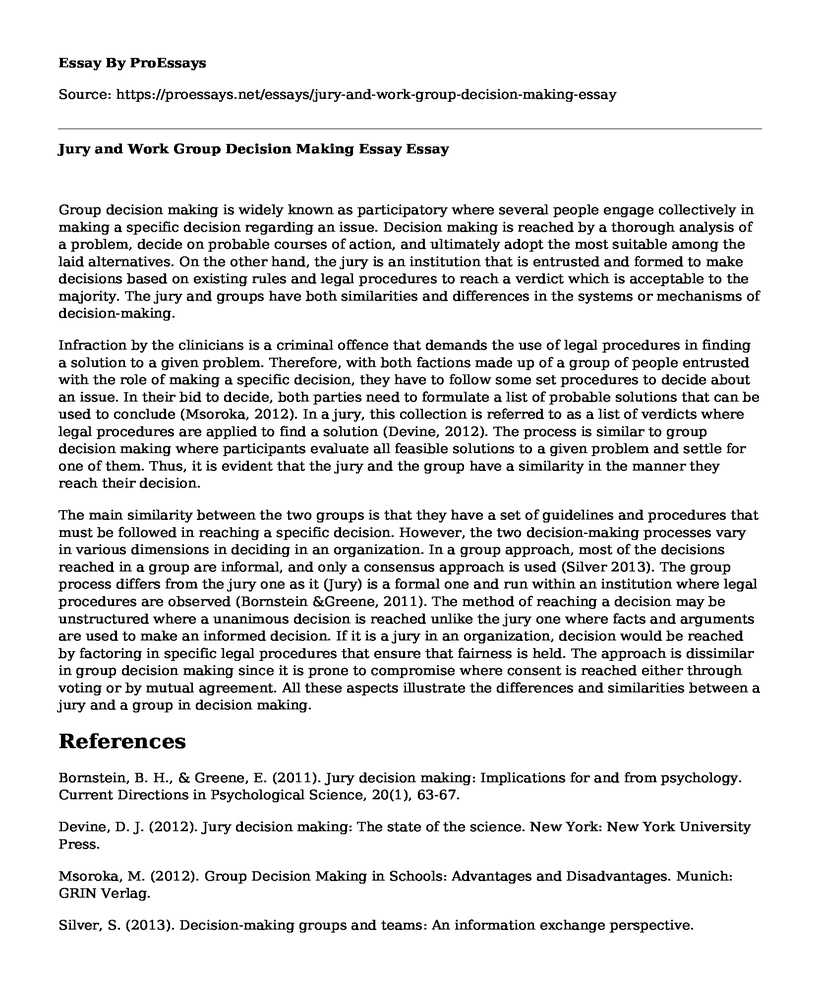Group decision making is widely known as participatory where several people engage collectively in making a specific decision regarding an issue. Decision making is reached by a thorough analysis of a problem, decide on probable courses of action, and ultimately adopt the most suitable among the laid alternatives. On the other hand, the jury is an institution that is entrusted and formed to make decisions based on existing rules and legal procedures to reach a verdict which is acceptable to the majority. The jury and groups have both similarities and differences in the systems or mechanisms of decision-making.
Infraction by the clinicians is a criminal offence that demands the use of legal procedures in finding a solution to a given problem. Therefore, with both factions made up of a group of people entrusted with the role of making a specific decision, they have to follow some set procedures to decide about an issue. In their bid to decide, both parties need to formulate a list of probable solutions that can be used to conclude (Msoroka, 2012). In a jury, this collection is referred to as a list of verdicts where legal procedures are applied to find a solution (Devine, 2012). The process is similar to group decision making where participants evaluate all feasible solutions to a given problem and settle for one of them. Thus, it is evident that the jury and the group have a similarity in the manner they reach their decision.
The main similarity between the two groups is that they have a set of guidelines and procedures that must be followed in reaching a specific decision. However, the two decision-making processes vary in various dimensions in deciding in an organization. In a group approach, most of the decisions reached in a group are informal, and only a consensus approach is used (Silver 2013). The group process differs from the jury one as it (Jury) is a formal one and run within an institution where legal procedures are observed (Bornstein &Greene, 2011). The method of reaching a decision may be unstructured where a unanimous decision is reached unlike the jury one where facts and arguments are used to make an informed decision. If it is a jury in an organization, decision would be reached by factoring in specific legal procedures that ensure that fairness is held. The approach is dissimilar in group decision making since it is prone to compromise where consent is reached either through voting or by mutual agreement. All these aspects illustrate the differences and similarities between a jury and a group in decision making.
References
Bornstein, B. H., & Greene, E. (2011). Jury decision making: Implications for and from psychology. Current Directions in Psychological Science, 20(1), 63-67.
Devine, D. J. (2012). Jury decision making: The state of the science. New York: New York University Press.
Msoroka, M. (2012). Group Decision Making in Schools: Advantages and Disadvantages. Munich: GRIN Verlag.
Silver, S. (2013). Decision-making groups and teams: An information exchange perspective. Routledge.
Cite this page
Jury and Work Group Decision Making Essay. (2022, Aug 04). Retrieved from https://proessays.net/essays/jury-and-work-group-decision-making-essay
If you are the original author of this essay and no longer wish to have it published on the ProEssays website, please click below to request its removal:
- Multidisciplinary vs Interprofessional Teams in Medicine Essay
- Essay Sample on Manpower Selection: Crucial for Project Success
- Essay on HRM Powers for Smooth Operations: A Netflix Case Study
- Project Manager Can Design Organization Structure: 3 Options - Essay Sample
- Essay on Re-Designing Wards at McLean Hospital to Reduce Aggression in Mental Illness Patients
- Paper Sample on Global Leadership: Essential for International Business
- Essay Example on Grow Business with GYB & DYB: Augmenting Business Sustainability







